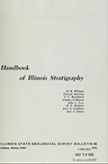Historical:Montrose Chert Member
Lithostratigraphy: Mammoth Cave Limestone Megagroup >>Keokuk Limestone >>Montrose Chert Member
Chronostratigraphy: Paleozoic Erathem >>Mississippian Subsystem >>Valmeyeran Series
Allostratigraphy: Kaskaskia Sequence
Authors
Elwood Atherton, Charles Collinson, and Jerry A. Lineback
Name Origin
The Montrose Chert Member of the Keokuk Formation (Keyes, 1895, p. 320) is named for Montrose, Lee County, Iowa. Earlier, these beds had been termed the "Keokuk cherty limestones" (Owen, 1852) or the "cherty beds of passage" separating the Keokuk and Burlington (Hall, 1857).
Type Section
The type section of the Montrose Chert Member consists of 30 feet of very cherty limestone at the base of the Keokuk Limestone where it is exposed along the Mississippi River between Montrose and Keokuk.
Extent and Thickness
The Montrose Chert Member is generally about 30 feet thick and consists of gray, medium- to coarse-grained, fossiliferous limestone and light gray dolomite in beds 2-10 inches thick.
Description
The Montrose Chert Member contains nodules and beds of blue-gray chert. The chert is dominant in many places and commonly is strongly brecciated (Collinson, 1964).
References
COLLINSON, CHARLES, 1964, Western Illinois: 28th Annual Tri-State Field Conference, Quincy, Illinois, Illinois State Geological Survey Guidebook Series 6, 30 p.
HALL, JAMES, 1857, Observations upon the Carboniferous limestones of the Mississippi Valley (abstract): American Journal of Science, v. 23, p. 187-203.
KEYES, C. R., 1895, Geology of Lee County: Iowa Geological Survey, v. 3, p. 305-407.
OWEN, D. D., 1852, Report of a geological survey of Wisconsin, Iowa, and Minnesota and incidentally of a portion of Nebraska Territory: Philadelphia, 638 p.
ISGS Codes
| Stratigraphic Code | Geo Unit Designation |
|---|---|
